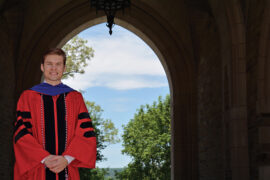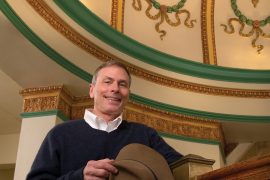A Huntington Museum of Art exhibit offers a lesson about culture and religion during Egypt’s 21st Dynasty.
By Marla Brannan
HQ 47 | SPRING 2003
Upon your death your family doesn’t bury you in a pre-arranged, mass-produced casket ordered through the funeral home. Instead, a coffin is made specifically for you, with a beautiful idealized human face on the lid and with hand-painted allusions to American history, culture and religion covering the outside. Your family could choose an American flag, an eagle or perhaps the 23rd Psalm written longhand.
The Huntington Museum of Art currently exhibits just such a coffin – with the minor difference that this one dates to Egypt’s 21st Dynasty (1075-945 B.C.) and houses a three thousand-year-old human mummy. These two extraordinary objects are on loan until 2005 from the Michael C. Carlos Museum at Emory University, Atlanta. The Mummy! exhibit also contains 20 funerary and daily life artifacts from the Metropolitan Museum of Art in New York. These range in date from approximately 1400 to 500 B.C. and add background and context to the coffin and its mummy.
For Sue D’Auria, HMA’s associate curator and Egyptologist, the coffin is the most spectacular aspect of the Mummy! exhibit. “While the mummy and artifacts are fascinating, the coffin is important because its decoration and construction explain a lot about Egyptian culture and religion during the 21st Dynasty.” Sue, who holds a Masters in Egyptology from the University of Pennsylvania and comes to HMA after 20 years at Boston’s Museum of Fine Arts, goes on to explain that the religious symbols and texts, once found on inner tomb walls, were handpainted on the coffin to help transport the deceased to the afterlife.

On this coffin, the deceased is pictured as a human-headed ba-bird, which Egyptians believed could fly between this world and the tomb, and is also depicted presenting bread and other offerings to the gods. The gods and goddesses themselves, including Nut, Horus and the sons of Horus, are represented in many forms. The coffin also reflects the Egyptian culture’s concentration on the cycles of life, or birth and rebirth, with numerous pictures of the scarab beetle and lotus flower.
Even the shape of the coffin, or “chest of life” as they were called, is filled with meaning. The anthropoid or mummy shape refers to the god of the dead, Osiris. The lid represents the sky, so it has images of the sky-goddess Nut, and the base represents the earth. The yellow background color identifies the deceased with the gods, whose skin was made of gold. Because of some minor damage to the top of the coffin, the wooden construction is seen plainly. It is interesting to note that, despite its importance as a vehicle for the dead, this coffin is constructed from numerous pieces of wood held together by dowels. This points to the reality of living in ancient Egypt where 90 percent of the country was treeless desert.
Egyptologists believe this coffin came from Thebes, center for the worship of the god Amun, and theorize that the person buried in it was an official or priest. Although his name unfortunately has not survived, it is believed the body is that of a male who died between the ages of 20 and 35.

The mummification process spanned 70 days: First, the lungs, liver, stomach and intestines were removed and placed in funerary jars topped with small busts of the four sons of Horus. By the 21st Dynasty they were wrapped and replaced, and the now solid funerary jars became “dummies.” The brain was removed through the nose; the heart was the home of intelligence and it remained untouched. (Curiously, mummies have been found where the heart had been removed accidentally and stitched back into its cavity.) An Egyptian salt called natron was then pressed into and around the corpse; after 40 days, the body was completely dehydrated. After packing it with materials intended to reshape it and make it smell pleasant, the corpse was wrapped in many layers of linen, sometimes bed sheets collected for this purpose during the person’s life.
Emory University Hospital took CT scans and X-rays of this mummy and found some interesting details. (The results of their findings are also on display.) This man was wrapped diagonally in only six layers of linen, a small number for the time, and its packing included a shawl with fringe and a mended shirt. The linen near the heart had been cut and partly unwrapped, probably the work of grave robbers seeking jewelry or amulets.
Egyptologists believe this corpse was treated roughly after death (possibly during transport on the Nile River) because its ribs in particular are broken and jumbled. And unlike most mummies from this era, this one still contains several organs, including the brain. Although the man behind this mummy is a mystery, the coffin and CT scans help defray scenes from B movies and cartoons and show that this was a human being with a strong cultural and religious heritage.

Like props setting the scene in a stage production or film, the 20 artifacts from the Metropolitan Museum of Art add depth to the coffin and mummy. Included are a stela or inscribed tablet, shabtis (funerary figures) made of faience, numerous amulets and pieces of jewelry, and a pot used in the mummification and burial of Tutankhamen. Also included is a charming statuette of Ked, the Chamberlain of Amun, with his wife and daughter. According to Sue, ancient Egyptians were optimistic people who enjoyed life and placed a high premium on family; Ked and his wife, arms around each other, certainly seem happy.
Though it appears an unlikely story, the Carlos Museum acquired this and a number of other coffins and mummies for $2 million from the Niagara Falls Museum and Daredevil Hall of Fame when the latter closed in 1999. The citizens of Atlanta raised the money in just two weeks. The Huntington Museum of Art is borrowing the coffin and mummy through the Museum Loan Network (MLN), an MIT-based national collection-sharing program that facilitates the long-term loan of objects between museums. The objects are listed in a computerized directory which covers more than 8,000 pieces of art from 60 different museums. The objects represent over 1,000 cultures.
According to the MLN web site, “The Museum Loan Network facilitates and funds the long-term loan of art and objects of cultural heritage among U.S. institutions as a way to enhance the installations of museums, thus enabling them to better serve their communities. The MLN grant programs help museums respond to the increasing public demand for installations that are relevant to a range of age groups and cultural heritages, and to better provide artistic, cultural and historical contexts for works on display. The MLN programs have led to the sharing of objects among different types of museums, fostering collaborations between institutions of varying size and discipline throughout the United States.”

Funding for Mummy! is provided by the Jacob G. Schmidlapp Fund and its sponsors are Fifth Third Bank, Huntington Mall, West Virginia Humanities Council, Cabell County Commission and West Virginia, Wild and Wonderful.
Well over 14,000 people have seen Mummy! since its opening January 18th, but the actual exhibit isn’t the only opportunity HMA offers to learn about ancient Egyptian culture. Numerous specialists from around the globe will speak at HMA over the two year exhibition period, most imminently, Dr. John Taylor. Dr. Taylor is an author and Keeper of Egyptian Antiquities at The British Museum and will lecture on “A Good Burial in the West: Ancient Egyptian Funerary Practices.” He is particularly well-versed in Egyptian coffins; it was the topic of his dissertation.

The Museum offers numerous unique ways to supplement your Mummy! experience throughout this year besides Dr. Taylor’s lecture. For the plant lover, Dr. Mike Beck, Director of HMA’s Conservatory, will hold a workshop entitled “Aquatic Plants of Ancient Egypt.”
The workshop is scheduled for June 14 at 10 a.m. For the avid reader, book discussions covering Egyptian topics will be held May 6 and October 7, both at 7 p.m. The books will be available at the Museum shop. For more information call David Owens at 529-2701, ext. 47.

And for everyone, Sue D’Auria will be conducting Gallery Talks in the Mummy! exhibit on June 10 at 7 p.m. and on October 31 at noon with a Halloween Luncheon at Café Bauhaus.
Entrance to the museum is free, but Mummy! costs $3 per person or $10 for a family of four or more. Entrance to the exhibit is free on Tuesdays.
For more information concerning hours, tours and future Mummy! events, log on to www.hmoa.org, or call the museum at 529-2701.





